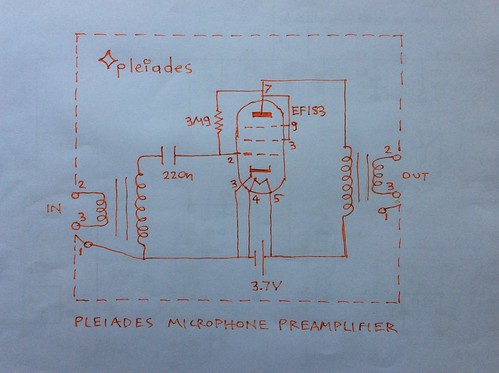This is the Pleiades V6 headamp schematic.

How would it sound with a K117 JFET for example? Would it be possible to do away with no source bias resistor or shunt capacitor?
On older Pleiades experiments on resistance coupled 1, 2 or more stage electron tube or JFET microphone preamps, the electron tubes had in general better sound and better overload characteristics as expected. [Russel O. Hamm]. Nevertheless the single Pleiades K117 head mic amp sounds very nice powered as one would an electret mic JFET. And on bipolar transistors the 2N3053 gives an amazing sound quality directly driving a 800Ω Philips loudspeaker. [euroelectron]
Another cause of different sound should be the typical 100KΩ input impedance of the EF183 electron tube on the Pleiades circuit as opposed to many MΩ of the JFET exagerating a transformer secondary reasonance. A more meaningful comparison should be made with a 100KΩ gate to ground resistor. Or if bias conditions allow a few MΩ from drain to gate. Perhaps a 700mV voltage source may be needed to be added to simulate electron cloud negative biasing on the grid. Perhaps also a diode between gate and source to simulate the grid rectification change in bias on electron tubes at overload. This acts as a side chain signal reducing the gain making overload gentler. An automatic gain control or compressor type of behaviour. When the grid start becoming positive near overload electrons are attracted to the grid. The grid becomes more negative ie anode current decreases and with it the gain of the electron tube. [euroelectron].
Using electron tubes, EF183, 7586, ECC82 the Pleiadss V6 sounds very low noise and revealing at 50-100 μA anode current. The ECC82 has not been tried yet at exactly this circuit, but it has been tried in similar subset circuits, Pleiadss V0, V2, V3 etc.
Would the same happen with the JFET? Can it be powered by just a few hundred millivolts? So far a few hundred millivolts gave a very interesting electric bass guitar sound in older Pleiades experiments.
It may be easy to phantom power using a center tap on the output transformer secondary.
Can the Nuvistor implementation be phantom powered in a similar way?
Would clean battery power sound the best?
Which batteries sound the best?
From experience, lead acid sound somewhat more slow. Ni-Mh sound nice as well as lithium batteries. Lithium batteries need more careful charging conditions.
References:
Tubes vs Transistors, is there an audible difference? - Russel O. Hamm - JAES
Pleiades 2N3053 directly driving Philips AD5046N - euroelectron
Neumann U47 tricks - euroelectron

How would it sound with a K117 JFET for example? Would it be possible to do away with no source bias resistor or shunt capacitor?
On older Pleiades experiments on resistance coupled 1, 2 or more stage electron tube or JFET microphone preamps, the electron tubes had in general better sound and better overload characteristics as expected. [Russel O. Hamm]. Nevertheless the single Pleiades K117 head mic amp sounds very nice powered as one would an electret mic JFET. And on bipolar transistors the 2N3053 gives an amazing sound quality directly driving a 800Ω Philips loudspeaker. [euroelectron]
Another cause of different sound should be the typical 100KΩ input impedance of the EF183 electron tube on the Pleiades circuit as opposed to many MΩ of the JFET exagerating a transformer secondary reasonance. A more meaningful comparison should be made with a 100KΩ gate to ground resistor. Or if bias conditions allow a few MΩ from drain to gate. Perhaps a 700mV voltage source may be needed to be added to simulate electron cloud negative biasing on the grid. Perhaps also a diode between gate and source to simulate the grid rectification change in bias on electron tubes at overload. This acts as a side chain signal reducing the gain making overload gentler. An automatic gain control or compressor type of behaviour. When the grid start becoming positive near overload electrons are attracted to the grid. The grid becomes more negative ie anode current decreases and with it the gain of the electron tube. [euroelectron].
Using electron tubes, EF183, 7586, ECC82 the Pleiadss V6 sounds very low noise and revealing at 50-100 μA anode current. The ECC82 has not been tried yet at exactly this circuit, but it has been tried in similar subset circuits, Pleiadss V0, V2, V3 etc.
Would the same happen with the JFET? Can it be powered by just a few hundred millivolts? So far a few hundred millivolts gave a very interesting electric bass guitar sound in older Pleiades experiments.
It may be easy to phantom power using a center tap on the output transformer secondary.
Can the Nuvistor implementation be phantom powered in a similar way?
Would clean battery power sound the best?
Which batteries sound the best?
From experience, lead acid sound somewhat more slow. Ni-Mh sound nice as well as lithium batteries. Lithium batteries need more careful charging conditions.
References:
Tubes vs Transistors, is there an audible difference? - Russel O. Hamm - JAES
Pleiades 2N3053 directly driving Philips AD5046N - euroelectron
Neumann U47 tricks - euroelectron
No comments:
Post a Comment